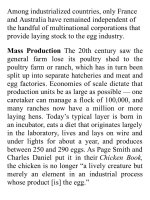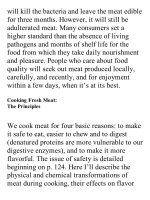On food and cooking the science and lore of the kitchen ( PDFDrive ) 101
Bạn đang xem bản rút gọn của tài liệu. Xem và tải ngay bản đầy đủ của tài liệu tại đây (166.27 KB, 2 trang )
With the helpful interference of the
lactoglobulins, the casein particles can only
bond to each other at a few spots, and so
gather not in clusters but in a fine matrix of
chains that is much better at retaining liquid
initssmallinterstices.
The Fermentation Once the milk has been
heated, it’s cooled down to the desired
fermentation temperature, the bacteria are
added (often in a portion of the previous
batch), and the milk kept warm until it sets.
The fermentation temperature has a strong
influence on yogurt consistency. At the
maximum temperature well tolerated by the
bacteria, 104–113ºF/40–45ºC, the bacteria
growandproducelacticacidrapidly,andthe
milkproteinsgelinjusttwoorthreehours;at
86ºF/30ºC,thebacteriaworkfarmoreslowly,
andthemilktakesupto18hourstoset.Rapid
gelling produces a relatively coarse protein
network whose few thick strands give it
firmness but also readily leak whey; slow
gelling produces a finer, more delicate, more
intricatelybranchednetworkwhoseindividual
strands are weaker but whose smaller pores
arebetteratretainingthewhey.
FrozenYogurt Frozenyogurtbecamepopular
in the 1970s and ’80s as a low-fat, “healthy”
alternativetoicecream.Infact,frozenyogurt
is essentially ice milk whose mix includes a
smalldoseofyogurt;thestandardproportion
is4to1.Dependingonthemixingprocedure,
the yogurt bacteria may survive in large
numbersorbelargelyeliminated.
SouredCreamsandButtermilk,IncludingCrèmeFrche
Beforetheadventofthecentrifugalseparator,
butterwasmadeinwesternEuropeby
allowingrawmilktostandovernightor
longer,skimmingoffthecreamthatroseto
thetop,andchurningthecream.Duringthe









